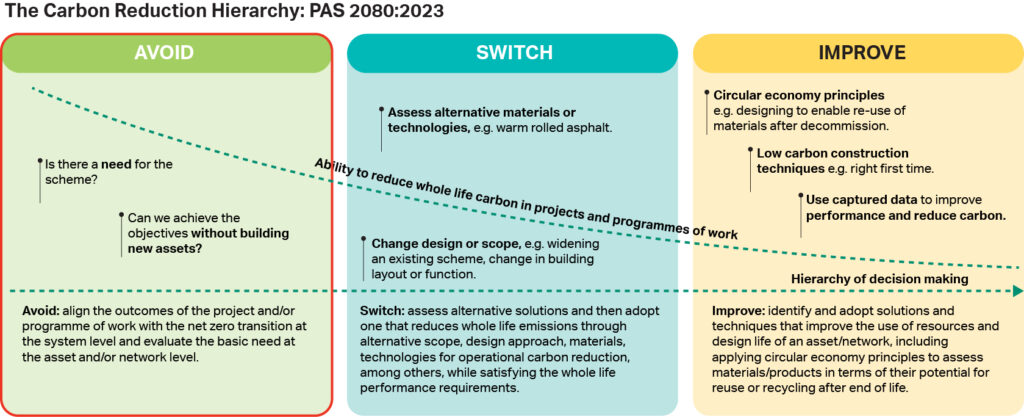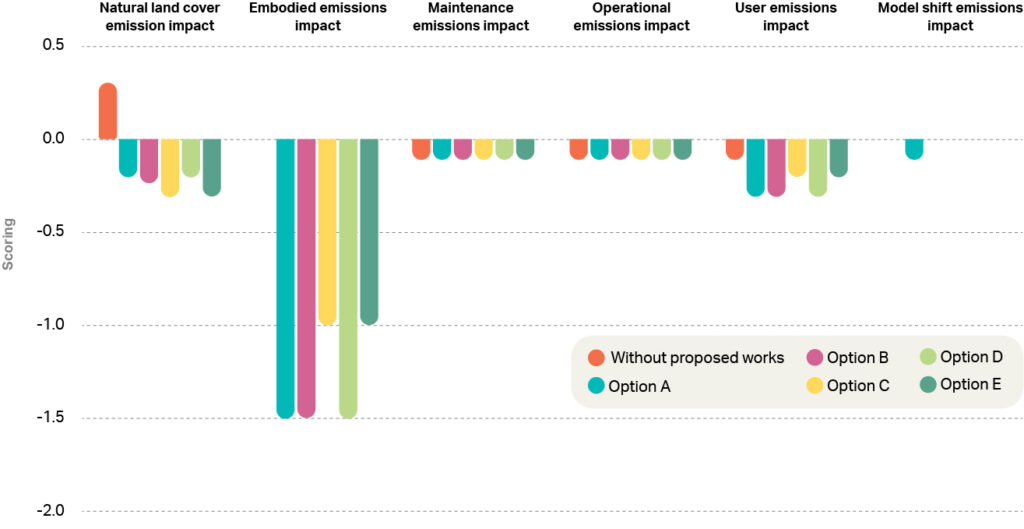Six things we have learnt about the revised PAS2080:2023 standard
It has been over a year since the updated PAS 2080:2023 standard was introduced, broadening it’s built environment scope to include buildings as well as infrastructure, encouraging the adoption of whole life and systems thinking.
So, how successful has PAS 2080: 2023 been in achieving its goals? Carbon experts Chris Landsburgh and Kallum Desai share their thoughts.
The updated PAS 2080:2023 standard (Carbon Management in Buildings and Infrastructure) was introduced just over a year ago with the intention of harmonising and enhancing decarbonisation efforts across the built environment industry by expanding the scope of the framework to include the built environment and ensure closer alignment with a 1.5-degree climate change scenario.
At the time, we described it as “a huge leap forward for the decarbonisation of the built environment [which our industry] must all work together to deliver.”
Over the past year, we’ve been applying PAS 2080 on major schemes aimed at alignment and certification and within procurement frameworks where compliance is a mandatory qualification. We have also been applying it across a range of sectors, including roads, rail, water, aviation and masterplanning.
So, how successful has it been in achieving its goals?
In this article, we share three ways we’ve successfully used the revised standard to help our clients make a tangible impact, as well as three areas where we see room for improvement.
Three successes
Without question, the new PAS has challenged us and the entire value chain to adopt a more innovative approach to decarbonisation through the application of the “whole of life” approach. This has fostered greater collaboration across the industry and the value chain, which supports the PAS 2080 principle of infrastructure and buildings being part of an interconnected system.
For instance:
1/More focus on the optioneering stage is supporting decision-making
The updated Carbon Reduction Hierarchy states, “the greatest ability to influence whole life carbon reduction is at the ‘need/avoid’ stage” (see Figure 1).
This encourages our clients to put more emphasis on the optioneering stage before they select a preferred option for design. This is good because the optioneering stage provides valuable carbon, climate, circular economy and biodiversity opportunities by challenging the scope and concept before we delve into project materials or construction methodologies.
Within the buildings sector, this has included supporting clients to evaluate opportunities for retrofitting, as opposed to building new. This supports informed early-stage decision making, thereby enabling whole life carbon emissions to be avoided and reduced.
However, since quantitative project data is often limited at the optioneering stage, we’ve been supporting clients in making decisions using qualitative data instead.

For example, in partnership with National Highways (NH) on a major road scheme, we used qualitative data to assess the whole-life carbon impact of five design options as part of the scheme’s carbon management plan. This allowed NH to compare each option, understanding the potential magnitude of emissions associated with each throughout the whole lifecycle, versus the impact of taking no action at all (see Figure 2).

2/The new clause on procurement is having a positive impact
Clause 10, which addresses procurement, is a significant update to the PAS 2080 standard, introducing guidance on contracts and supply chain engagement. This new clause is already making a difference.
We have been advising Transport for London (TfL) as it evaluates its requirements for concrete, steel and asphalt, three common materials with high embodied carbon commonly used in infrastructure projects, providing them with expertise and feedback on their material requirements. Furthermore, to establish market readiness for these requirements, we engaged key suppliers in the industry as well as authors of the main material roadmaps and benchmarking schemes for concrete such as LCCG.
In addition, we have successfully worked with clients to develop specific requirements within their invitations to tender that ensure a successful carbon management strategy can be enacted. This has included developing bespoke tender questions to evaluate prospective approaches to carbon management. Through optimising the procurement of services, carbon management can be built into projects from day one, helping to ensure that opportunities for whole life carbon reductions can be maximised at each stage of a project.
3/PAS 2080: 2023 is driving engagement on a systems-level
From our experience, PAS 2080 is succeeding in encouraging a systems-level approach to decarbonisation by bringing more industry stakeholders into the conversation across the value chain.
However, this is not without its challenges. To be effective, a carbon management plan (CMP) must be understood by people and organisations with differing levels of carbon knowledge. Traditional 100-page CMPs are increasingly seen as insufficient for this purpose.
In response, we have been trialling a different approach, distilling the CMP into an easy-to-digest format. Stakeholders can visualise the PAS 2080 whole lifecycle approach when applied to their asset or network and can clearly identify the actions they must take. Equally, we can show how the CMP aligns with broader regional and national policy.
To date, we have successfully used this novel method on projects across the UK, including working with TfGM on their project in Farnworth, Bolton and Oxfordshire County Council’s Access to Whitney project.
Three future considerations for continuous improvement
While the infrastructure sector has been quick to adopt PAS 2080 principles, we’re now seeing a broader range of clients, consultants, and construction firms across the whole built environment aiming for compliance, driven by framework requirements and corporate goals.
While PAS 2080 is helping our clients better manage the carbon impact of their assets, continual improvement remains a core part of the carbon management process. Here are three future considerations that we have identified:
1/More consistency and improved scalability
There is still some way to go before PAS 2080 moves beyond an infrastructure focus towards holistic adoption at a masterplan level. To scale up, its application must extend to analyse the relationship between plots and the public realm, ensuring system-level decisions are being made.
The principles must also be applied consistently; at present, too many carbon assessments and management plans are being carried out in different ways. Improving cross-industry consistency will support greater robustness in the carbon management approach, which in turn will help to drive reductions in carbon emissions.
2/Greater alignment with regulatory frameworks
We need alignment between PAS 2080 and regulatory frameworks to enhance implementation and effectiveness. Cooperation is critical here. Government departments, local councils and professional bodies such as the Department for Transport (DfT), and the Royal Institution of Chartered Surveyors (RICS) must work together to embed consistency in their guidance and frameworks.
3/Avoiding ‘carbon tunnel vision’
When applying PAS 2080, practitioners need to ensure they avoid ‘carbon tunnel vision’ – where the focus lies solely on carbon reduction, as there may be unintended consequences for other ESG issues. This means considering additional sustainability themes, such as nature-based solutions, the circular economy, climate resilience, biodiversity, and double materiality.
The effectiveness of this approach is highly dependent on the competency of practitioners, who must be equipped with the necessary knowledge and skills to balance these diverse priorities. To avoid ‘carbon tunnel vision,’ we engage experts from our in-house multidisciplinary teams, ensuring the diversity of thought and experience necessary to address sustainability on both macro (across sustainability themes) and micro (across impact categories) scales (see Figure 3 below).
PAS 2080 should also strive to include more granular detail on material composition and impact. While the impact of some materials on greenhouse gas emissions may be low, a more pronounced impact on areas like land use, water use, or eutrophication can offset this.

Continuous improvement is everyone’s responsibility
At AECOM, we recognise PAS 2080’s enormous potential as a platform for rapid change. As an industry, we’ve made great progress in its application, but there’s more to come.
That’s why we continue to support the PAS 2080 Technical Advisory Panel and the Institution of Civil Engineers to advise industry, collaborate and share best practices as widely as possible. We also support the industry through initiatives such as the ICE Carbon Champions Initiative and the Built Environment Carbon Database.
By sharing our experiences and insights with PAS 2080, we can refine our approaches, fully unlock the standard’s potential, and not only enhance the decarbonisation of projects but also bolster our collective expertise in carbon management. Together, we can ensure PAS 2080 succeeds in its goal in driving the industry toward a more sustainable future.
What is PAS 2080:2023?
The PAS 2080:2023 (PAS 2080) standard was introduced in 2023 and is a revised version of an earlier PAS 2080 specification introduced in 2016 by the British Standards Institution (BSI).
This updated PAS 2080 standard is intended to harmonise and enhance decarbonisation efforts across the built environment by expanding the scope of the framework to include buildings as well as infrastructure, ensuring closer alignment with a 1.5-degree climate change scenario.
The framework outlines various decarbonisation principles and includes a guidance document with relevant case studies.
Watch this video with carbon and ESG director Sally Vivian to learn about ‘carbon tunnel vision’ and how to avoid it






